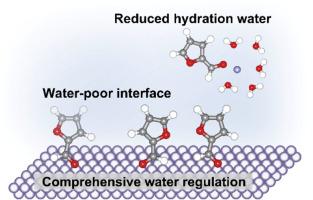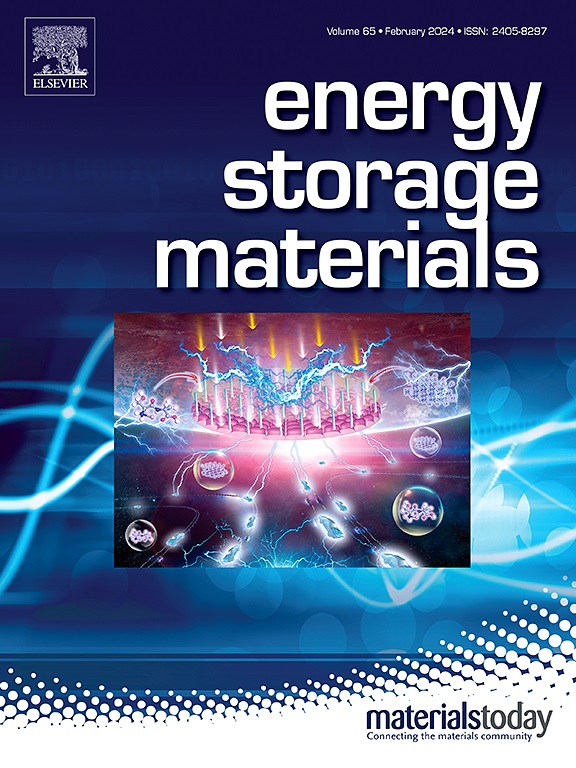Comprehensive water regulation via nucleophilic aldehyde for stable zinc anodes
IF 18.9
1区 材料科学
Q1 CHEMISTRY, PHYSICAL
引用次数: 0
Abstract
The application of zinc anode in aqueous zinc-ion batteries (AZIBs) is severely impeded by dendrite growth and side reactions. In this study, trace furfural (FF) was introduced into zinc sulfate electrolyte as a nucleophilic ligand to achieve comprehensive water regulation, targeting both interfacial water and the solvated water of hydrated zinc ions. Experimental and theoretical analyses reveal that nucleophilic FF molecules enter the solvation sheath of zinc ions and replace active water molecules, thus suppressing hydrogen evolution. Furthermore, FF molecules induce a water-deficient electric double layer by preferentially adsorbing on the zinc surface, which not only inhibits anode corrosion but also refines zinc crystals, thereby achieving uniform zinc deposition. As a result, the symmetric Zn||Zn cell with FF-ZnSO4 electrolyte exhibits an extended cycle life and maintains stable of over 2980 h at a current density of 0.5 mA cm−2. Even at the ultra-high current density of 22 mA cm−2, the voltage polarization is stable at 0.12 V, demonstrating excellent rate performance. The Zn||VPH-sol-V2O5 full cells also demonstrate superior capacity retention and rate performance, underscoring the practical potential of this strategy. This study highlights the regulation role of nucleophilic ligands in limiting water activity in aqueous zinc-ion batteries.


亲核醛对稳定锌阳极的综合水调控
锌阳极在水性锌离子电池中的应用受到枝晶生长和副反应的严重阻碍。本研究将微量糠醛(FF)作为亲核配体引入硫酸锌电解质中,实现了对界面水和水合锌离子的溶剂化水的综合水调节。实验和理论分析表明,亲核FF分子进入锌离子的溶剂化鞘,取代活性水分子,从而抑制析氢。此外,FF分子通过优先吸附在锌表面,诱导出缺乏水的双电层,既抑制阳极腐蚀,又细化锌晶体,从而实现均匀的锌沉积。结果表明,采用FF-ZnSO4电解液制备的对称Zn||电池在0.5 mA cm−2电流密度下具有较长的循环寿命,可保持2980 h以上的稳定性。即使在22 mA cm−2的超高电流密度下,电压极化也稳定在0.12 V,表现出优异的速率性能。Zn||VPH-sol-V2O5全电池也表现出优异的容量保持和倍率性能,强调了该策略的实际潜力。本研究强调了亲核配体在限制水性锌离子电池水活度中的调节作用。
本文章由计算机程序翻译,如有差异,请以英文原文为准。
求助全文
约1分钟内获得全文
求助全文
来源期刊

Energy Storage Materials
Materials Science-General Materials Science
CiteScore
33.00
自引率
5.90%
发文量
652
审稿时长
27 days
期刊介绍:
Energy Storage Materials is a global interdisciplinary journal dedicated to sharing scientific and technological advancements in materials and devices for advanced energy storage and related energy conversion, such as in metal-O2 batteries. The journal features comprehensive research articles, including full papers and short communications, as well as authoritative feature articles and reviews by leading experts in the field.
Energy Storage Materials covers a wide range of topics, including the synthesis, fabrication, structure, properties, performance, and technological applications of energy storage materials. Additionally, the journal explores strategies, policies, and developments in the field of energy storage materials and devices for sustainable energy.
Published papers are selected based on their scientific and technological significance, their ability to provide valuable new knowledge, and their relevance to the international research community.
 求助内容:
求助内容: 应助结果提醒方式:
应助结果提醒方式:


